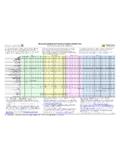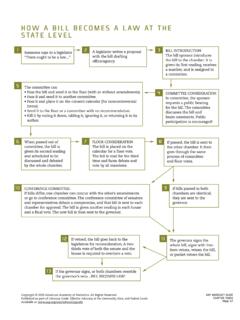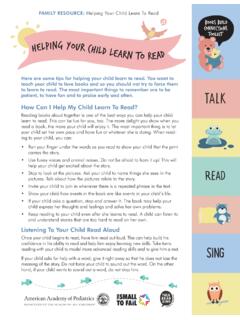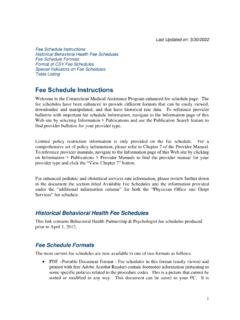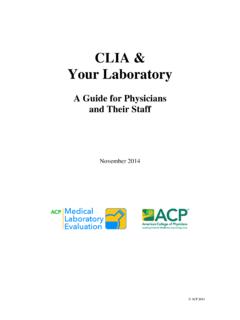Transcription of Oral Health Coding Fact Sheet for Primary Care Physicians
1 Current Procedural Terminology 2020 American Medical Association. All Rights Reserved. D codes are covered under the Code on Dental Procedures and Nomenclature copyright by the American Dental Association. Oral Health Coding Fact Sheet for Primary Care Physicians CPT Codes: Current Procedural Terminology (CPT) codes are developed and maintained by the American Medical Association. The codes consist of 5 numbers (00100 - 99999). These codes are developed for Physicians and other Health care professionals to report medical procedures to insurance carriers for payment. CDT Codes: Code on Dental Procedures and Nomenclature (CDT) codes are developed and maintained by the American Dental Association. These codes provide a way to accurately record and report dental treatment. The codes have a consistent format (Letter D followed by 4 numbers) and are at the appropriate level of specificity to adequately encompass commonly accepted dental procedures. These needs are supported by the CDT codes.
2 CDT codes are rarely, if ever, covered by commercial Health insurance. CDT codes are included here because some commercial plans may cover, but more often State Medicaid plans may cover. Check with your payers and your fee schedule for more information. Prophylaxis and Fluoride Varnish 99188 Application of topical fluoride varnish by a physician or other qualified Health care professional This code was approved to begin January 1, 2015. It only includes varnish application, not risk assessment, education, or referral to a dentist. The USPSTF recommended this for children up to 6 years of age. Therefore Code 99188 must be covered by commercial insurance by May 2015 for children up to age 6. Check with your insurers for specifics. The relative value unit (RVU) for CPT code 99188 (as of Jan 1, 2021) is as follows: o Total Non-facility Total o Total Facility The Section on Oral Health tracks payment for services. D1206 Topical application of fluoride varnish D1208 Topical application of fluoride 99429 Unlisted preventive medicine service 99499 Unlisted evaluation and management service 2021 Current Procedural Terminology 2020 American Medical Association.
3 All Rights Reserved. D codes are covered under the Code on Dental Procedures and Nomenclature copyright by the American Dental Association. Other Preventive Oral Health Services D1310 Nutritional counseling for the control of dental disease D1330 Oral hygiene instruction Clinical Oral Evaluation D0140 Limited oral evaluation, problem focused D0145 Oral evaluation for patient under 3 years of age and counseling with Primary caregiver Oral Procedures D7140 Extraction, erupted tooth or exposed root (elevation and/or forceps removal) Alternate Coding : CPT code 41899 Unlisted Procedure, dentoalveolar structures While use of a more specific code (ie, D7140) is preferable to a nonspecific code (ie, 41899), reporting the CPT code may increase a pediatrician s likelihood of getting paid. As an unlisted service, chart notes may need to accompany the claim. Modifiers For those carriers (particularly Medicaid plans under EPSDT), that cover oral Health care, some will require a modifier (See Private Payers and Medicaid below) SC Medically necessary service or supply EP Services provided as part of Medicaid early periodic screening diagnosis and treatment program (EPSDT) U5 Medicaid Level of Care 5, as defined by each state Other (Referral Codes) YD Dental Referral This referral code is used in the state of Pennsylvania for EPSDT services and may be used by other payers ICD-10-CM Codes Routine Encounter/Screening: Encounter for routine child Health examination with abnormal findings (Use additional code to identify abnormal findings, such as dental caries) Encounter for routine child Health examination without abnormal findings Encounter for screening for dental disorders Current Procedural Terminology 2020 American Medical Association.
4 All Rights Reserved. D codes are covered under the Code on Dental Procedures and Nomenclature copyright by the American Dental Association. Encounter for prophylactic fluoride administration Risk: Risk for dental caries, low Risk for dental caries, moderate Risk for dental caries, high Unspecified risk for dental caries Other: Diabetes Due to Underlying Condition with Periodontal Disease Drug/chem Diabetes Mellitus w/Periodontal Disease Type 1 Diabetes Mellitus with Periodontal Disease Type 2 Diabetes Mellitus with Periodontal Disease Mottled teeth Newborn Affected by Periodontal Disease in Mother Arrested dental caries Dental caries on pit and fissure surface limited to enamel Dental caries on pit and fissure surface penetrating into dentin Dental caries on pit and fissure surface penetrating into pulp Dental caries on smooth surface limited to enamel Dental caries on smooth surface penetrating into dentin Dental caries on smooth surface penetrating into pulp Dental caries, unspecified Acute gingivitis, plaque induced (Acute gingivitis NOS) Acute gingivitis, non-plaque induced Chronic gingivitis, plaque induced (Gingivitis NOS)
5 Chronic gingivitis, non-plaque induced Other Periodontal Diseases Periodontal Disease, Unspecified Gingival Recession Gingival Enlargement Current Procedural Terminology 2020 American Medical Association. All Rights Reserved. D codes are covered under the Code on Dental Procedures and Nomenclature copyright by the American Dental Association. Gingival & Edentulous Alveolar Ridge Lesions Associated with Trauma Complete Loss of Teeth Due to Periodontal Diseases, Class 1 Complete Loss of Teeth Due to Periodontal Diseases, Class II Complete Loss of Teeth Due to Periodontal Disease, Class III Complete Loss of Teeth Due to Periodontal Diseases, Class IV Complete Loss of Teeth Due to Periodontal Disease, Unspecified Class Partial Loss of Teeth Due to Periodontal Diseases, Class I Partial Loss of Teeth Due to Periodontal Diseases, Class II Partial Loss of Teeth Due to Periodontal Diseases, Class III Partial Loss of Teeth Due to Periodontal Diseases, Class IV Other specified disorders of teeth and supporting structures Halitosis Fracture of tooth (traumatic) Dislocation of tooth - A 7th character is required for both S02 and S03 to show the encounter.
6 7th character A would show that the encounter is for initial or active treatment Also include other codes that relate to the payer how the injury happened, including location and activity. Some states require the reporting of this information. Other Specified Counseling Inappropriate diet and eating habits Personal history of other medical treatment Private Payers and Medicaid Most private/commercial payers were required to pay for 99188 under the Health or medical plans for children up to age 6 by May, 2015 because the US Preventive Services Task Force recommended it as a Level B recommendation. They are not mandated to cover older children. The Primary reasons why medical Health plans do not cover the fluoride varnish, risk assessment, education, and referral to a dentist are that the Health plan does not include dental services, or if there is limited coverage for certain dental services, the provider network is limited to dentists or oral surgeons. Since most carriers claims systems do not recognize the dental service codes (D codes) on their medical claims platforms, CPT code 99188 was developed in 2015.
7 Starting in 2014, the Affordable Care Act requires that individual and small-group Health plans sold both on the state-based Health insurance exchanges and outside them on the private market cover pediatric dental services performed by dental professionals. However, Health plans that have grandfathered status under the Current Procedural Terminology 2020 American Medical Association. All Rights Reserved. D codes are covered under the Code on Dental Procedures and Nomenclature copyright by the American Dental Association. law, or employers whose plans are covered under ERISA by Third Party Administrators, are not required to offer this coverage. At the following link you can find a chart about Medicaid reimbursement and which codes to use by state However, please check with your individual state as their procedures change frequently without uniformity! FAQ Q. When was the new CPT code (99188) effective? A. The CPT Editorial Panel approved the new CPT code 99188 for implementation on January 1, 2015.
8 Q. May I still bill the CDT code for topical fluoride application to my Medicaid plan or must I use the new CPT code? A. If your Medicaid plan still requires and will pay on the CDT codes, you should continue to report the CDT codes as defined by your Medicaid plan. This will vary from state to state. Q. Our practice was happy to see the new CPT code; however, what does it mean by a physician or other qualified Health care professional ? A. In order to obtain approval by the CPT Editorial Panel, we had to include this language as part of the code descriptor. Inclusion of this language does limit who may perform and report the service. The CPT definition other qualified Health care professionals excludes clinical staff such as RNs and LPNs. Basically, an other qualified Health care professional is one who can independently practice and bill under her own name. In practice, this means that CPT requires a physician or other qualified Health care professional perform the topical fluoride application.
9 While state scope of practice and Medicaid qualifications may allow clinical staff (eg, RN) to perform this service, CPT guidelines do not allow the reporting of code 99188 in those instances. However, if you are able to work with your payers and get it in writing that they will allow clinical staff to perform the service based on state scope of practice, and report incident to the supervising provider, then you would be able to use the code. Note that the CDT codes do not have this restriction. Also, there is a caveat in the CPT Changes manual that alludes to the application of topical fluoride varnish to those patients with high risk for dental caries. Although code 99188 states application is done by physician or other qualified Health care professional, payers may allow billing of services by trained clinical staff under direct physician supervision (incident to). Some Medicaid plans require training of clinical staff through specific programs. It is important to identify the requirements of individual payers prior to providing this service and get any variations from CPT in writing.
10 Current Procedural Terminology 2020 American Medical Association. All Rights Reserved. D codes are covered under the Code on Dental Procedures and Nomenclature copyright by the American Dental Association. Q. Why was code 99188 not payable until recently? Also, what is the current relative value for 99188? A. Originally CMS decided not to publish the recommended RVUs however, through Advocacy efforts by the AAP, CMS agreed to publish the recommended RVUs. The current relative value units are: o Total Non-facility Total o Total Facility Q. What if a payer does not cover 99188? A. As of now, the only payer the AAP is aware of that will not across the board cover fluoride varnish is Tricare. If you are billing a Medicaid plan, make sure you are reporting the correct code as it may be a CDT code and not the CPT code. See the AAP reference. Otherwise please reach out to the AAP s Hassle Factor Form to inform the AAP of denials. Q. If this new CPT code (99188) is to be used for high risk caries how do you identify that?
